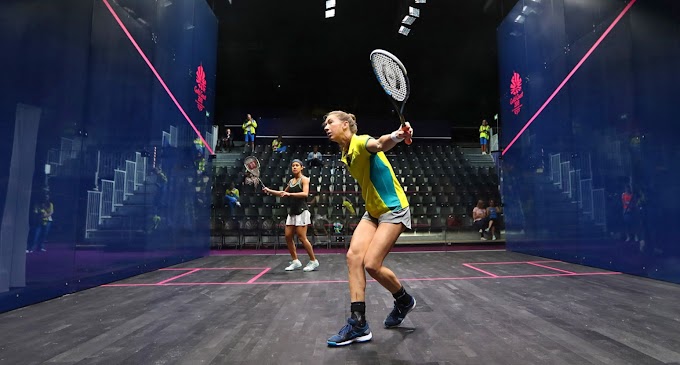Boxing, usually referenced to as the "sweet science," is a game that has entranced people for a really long time. With its foundations tracing all the way back to past advancements, Like Volleyball
enclosing has developed to a polished and complex form of warfare that requires both actual talent and smartness. In this detailed assistance, we will dig profound into the universe of boxing, studying its set of experiences, procedures, training, and the extraordinary culture that wraps it.
Part 1: A Concise History of Boxing
 |
| The Sweet Study of Boxing |
Boxing is one of the most established war sports known to mankind, and its set of experiences is a captivating adventure through time. The starting points of boxing can be linked back to ancient Egypt and Greece, where it was rehearsed as a type of distraction, actual wellness, and battle preparing. In these early advances, boxing missing the mark on regulations and guidelines we partner with the game today, usually motivating harsh and some of the time lethal experiences.
As time elapsed, boxing's fame expanded, and it transformed into an acclaimed sport in old Greece, with contenders employing calfskin straps folded over their clench palms as simple gloves. Notwithstanding, it was only after the eighteenth century that boxing started to come to maturity as a structured game in Britain.
The key second in the formation of present day boxing accompanied the foundation of the Marquess of Queensberry Rules in 1867. These principles, named for the ninth Marquess of Queensberry, normalized the game and introduced ideas that are today fundamental to boxing, like rounds, gloves, and a 10-second count for a beaten down competitor. This laid the establishment for the coordinated, controlled sport we know today.
Part 2: The Rudiments of Boxing
 |
| Far-reaching Manual for the Craft of the Ring |
Boxing is a game that spins around the trade of punching. At its center, the key goal is to deliver immaculate, compelling blows on your competitor while trying not to get hit yourself. We need go further into the key components of boxing:
1. Position: A respectable boxing position is vital to adjust, versatility, and protection. Fighters posture themselves with their feet shoulder-width separated, knees somewhat twisted, and hands held high to shield their face. The lead hand (the hand nearest to the rival) is frequently held out as a hit, while the back hand is saved close to the jaw for protection.
2. Punches: The principal punches in boxing are the hit, cross, snare, and uppercut. Each punch has its motivation and plan. The hit is a rapid, straight blow intended to manage distance and set up additional punches. The cross is a hard straight strike tossed with the back hand. Snares are bended blows that focus on the sides of the rival's head or torso, while uppercuts are short, up punches centered on the jaw.
3. Safeguard: While punching is crucial, powerful protection is as significant. Fighters should acquire cautious methods, for example, slipping, delaying, and rejecting punches to attempt not to take harm. Bouncing and twisting around are furthermore key features to evade approaching punches.
4. Footwork: Footwork is the cornerstone of portability in boxing. Fighters employ footwork to move around the ring, control distance, and make points against their rivals. Legitimate footwork permits a boxer to both charge and guard successfully.
Section 3: Preparing and Molding
 |
| The Sweet Study of Boxing: 7 Far-reaching Manual for the Craft of the Ring |
Fruitful fighters are formed through comprehensive preparation and molding programs. The physical and mental expectations of the game expect contenders to be in top form. Here are the important components of a fighter's preparation:
1. Cardiovascular Molding: Boxing requests uncommon perseverance. To create this perseverance, fighters partake in activities like roadwork, which entails jogging substantial distances, leaping rope, and intense competitive meetings. These exercises assist with working on cardiovascular wellbeing, guaranteeing that contenders can stay up with their speed all through a battle.
2. Strength and Molding: Strength is vital in boxing, as it adds to punching power, quickness, and generally physicality. Fighters employ weightlifting, plyometrics, and bodyweight activities into their preparation schedules to build fortitude, hazardousness, and spryness.
3. Specialized Preparing: To triumph in the ring, fighters should consummate their punching method. This includes shadowboxing, when warriors practice their movements and blends without an accomplice. Weighty pack drills and glove work with coaches permit fighters to refine their punches, exactness, and timing.
4. Competing: Controlled, managed combat meetings are a crucial aspect of a fighter's preparation. Competing permits warriors to employ their abilities in a sensible atmosphere, grow their ring intelligence level, and adjust to various combating techniques.
Part 4: The Psychological distraction
Boxing isn't merely an actual game; it's a psychological war too. Mental strength, center, and critical reasoning assume crucial parts in a fighter's prosperity. Here are a few major mental components of the game:
1. Perception: Numerous fighters employ representation tactics to get ready for confrontations mentally. They invest energy clearly visualizing diverse situations, techniques, and beneficial results. Perception helps construct certainty and hones the brain for rivalry.
2. Conquering Dread: Dread is a characteristic and strong inclination in boxing. Fighters should defy and deal with their nervousness to perform at their best. Figuring out how to channel anxiety emphatically and utilize it as a wellspring of inspiration can be the way to progress in the ring.
3. Technique and Strategies: Boxing isn't just about tossing punches randomly. Fighters should examine their adversaries, respond to shifting circumstances in the ring, and cultivate approaches for varied conflicts. Successful approach and strategies can have a big effect amid triumph and rout.
Part 5: Boxing Society
Boxing has a rich and active culture that combines conventions, rites, and a one of a kind feeling of brotherhood among combatants. This culture stretches out past the ring and deeply molds the existences of individuals engaged with the game. Here are a few parts of boxing society:
1. Boxing Rec centers: The boxing workout center is the basis of a fighter's preparation. It's a position of discipline, arduous labor, and change. In the rec center, competitors fashion their bodies as well as deep rooted bonds with trainers and individual fighters.
2. Battle Night Ceremonies: Fighters frequently have pre-battle rites and weird concepts that assist them with intellectually getting ready for the combat to come. These practices might go from specified feasts and warm-up regimens to particular ceremonies intended to provide best of luck.
3. Boxing Legends: Over now is the appropriate moment, boxing has developed many legends who have made a permanent stamp on the game. Symbols like Muhammad Ali, Mike Tyson, Sugar Beam Robinson, and numerous others carry on stirring fresh eras of warriors and fans the same.
Part 6: Boxing Procedures and Techniques
In the arena of boxing, conquering diverse techniques and systems is vital for advancement in the ring. This section will dig further into the intricacy of boxing processes and the fundamental aspects of the game.
1. Mixes: Boxing isn't simply about hurling solitary punches; it's tied connected with joining punches actually. Contenders figure out how to connect together mixtures of punches, for example, a poke cross-snare or a hit uppercut-snare. These combinations save adversaries cockeyed and open up open avenues for landing great shots.
2. Range The board: Understanding and regulating distance is a vital expertise in boxing. Warriors need to know when to remain outwardly and maximize their arrive at benefit, and when to get inside to land short proximity punches. Range the executives is a precarious equilibrium that requires steady modifications during a battle.
3. Countering: Boxing is a round of methodology, and countering is a key piece of it. Contenders learn out how to expect their rival's moves and counter with very much planned punches. Countering can be a profoundly viable approach for altering a rival's offense into a cautious open door.
4. Bluffing: Bluffing is the specialty of misdirecting your adversary. Fighters utilize unsophisticated innovations and false punches to produce gaps in their rival's defence. A professional bluff can lead an adversary into committing an error and leaving them defenseless against a counterattack.
5. Cautious Techniques: Powerful protection goes far obstructing and sidestepping punches. Fighters apply numerous cautious strategies, such utilizing head development, securing, and holding to kill their rival's offense. The choosing of protective system relies upon the warrior's style and the individual conditions in the ring.
Section 7: The Physical and Mental Difficulties of Boxing
Boxing is a truly requesting sport that pushes warriors as far as possible. Notwithstanding, it likewise provides mental challenges that might similarly as dismay. In this section, we'll study the physical and cerebral components of the game more methodically.
1. Weight The board: Numerous boxers compete in unmistakable weight divisions, which necessitates severe weight the executives. Contenders need to maintain up with their weight while assuring they have the energy and strength for preparing and contest. Weight reduction can be challenging and require meticulous preparation and discipline.
2. Injury The board: Boxing suggests a gamble of wounds, including cuts, injuries, and more catastrophic wounds including blackouts. Contenders should be mindful about their welfare and search for clinical consideration when required.
You may love this: Internet of things








nice
ReplyDeleteFeel free to let me know if any question